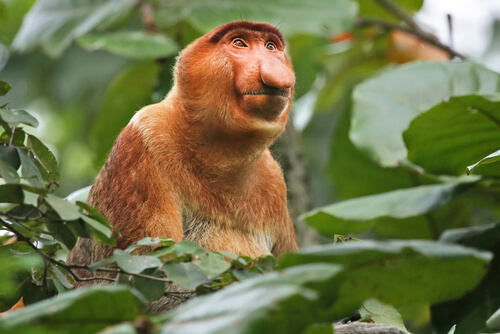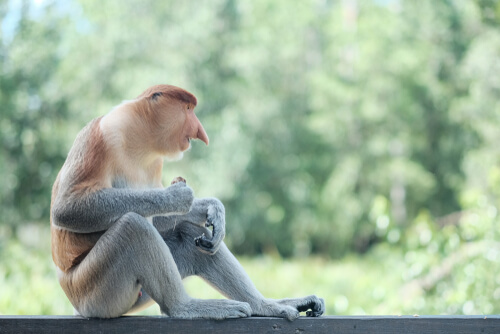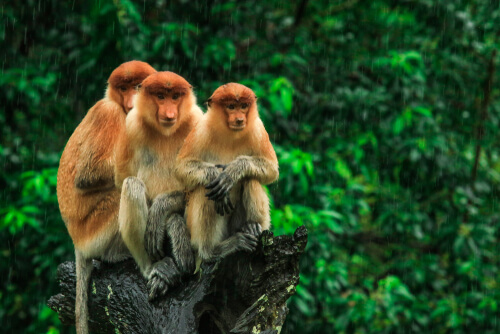
| Kingdom | Animalia |
| Phylum | Chordata |
| Class | Mammalia |
| Order | Primates |
| Family | Cercopithecidae |
| Genus | Nasalis |
| Species | Nasalis larvatus |
| Niche | Arboreal Primate |
| Length | 21-30 in (53-76 cm) |
| Weight | 15-50 lb (7-22.5 kg) |
| Lifespan | 20 years |
| Social Structure | Social, Hierarchical |
| Conservation Status | Endangered |
| Preferred Habitat | Arboreal |
| Average Number of Young | 1 baby |
| Main Prey Species | Leaves, seeds, fruits |
| Predators | Crocodiles, clouded leopards, birds of prey, monitor lizards, pythons |
The Basics
The proboscis monkey (Nasalis larvatus), is a large primate endemic to the island of Borneo. It is named after the long, hanging nose present in males and spends most of its time living in the trees near mangrove forests or jungle streams. It is also known as the long-nosed monkey and locally as the bekantan. Due to the threat of deforestation in its tropical rainforest habitat, populations of the species are in decline and it is listed as Endangered on the IUCN Red List.
Description
Male proboscis monkeys reach up to 50 lb (22.5 kg) while females are about half their size. Their fur is a light brown color with tones of red near the shoulders and head and some grey on their arms and legs. The head-body length of males is about 26-30 in (66-76 cm) while females grow to about 21-24 in (52-62 cm) in length. Males also have long, bulbous, and often hanging noses from which the species receives its namesake. These fleshy noses can grow to as long as 4 in (10 cm), often hanging lower than their mouths. These are absent in females monkeys which have smaller, triangular noses. All proboscis monkeys have webbed toes and fingers that aid in swimming.

Habitat
Proboscis monkeys are limited to the jungles of Borneo where they live near rivers, mangroves, and swampy areas. They are primarily arboreal, spending most of their time in the trees to avoid their many predators. They will occasionally move to the ground in search of food.
Like many primates, proboscis monkeys have a complicated social structure. Males tend to organize harems consisting of two to seven females and their young. These groups will often join up with other groups at night to find safety in numbers. In addition, there are often all-male groups while others will remain largely solitary. One-male groups will be headed by the same male for up to 6 or 8 years, with replacement usually occurring without violence or serious aggression.

Diet and Predators
Proboscis monkeys are omnivores, subsisting mostly on leaves and seeds they may forage from the ground or unripe fruits picked from the trees in which they live. Occasionally, they will eat insects as well.
Predators of the species include large and exotic animals such as jaguars, pythons, and crocodiles. Also, humans have historically hunted proboscis monkeys, with some indigenous peoples of the area considering it a delicacy.
Reproduction
Males will amplify their calls using their long, hanging nose, impressing females and intimidating other males. and sexes will use long, pouting faces and other displays when soliciting a mate. Following a brief, one-minute copulation and a gestation period of about 170-200 days, females will often give birth at night in the safety of a large band. Usually just one young is born, which nurses from the mother for up to 7 months. At about 6 weeks, the infant will also begin to consume some solid foods, supplementing their newborn diet. Females become sexually mature at about 5 years of age while individual monkeys live for around 20 years.

Conservation Status
Unfortunately, the Proboscis monkey is endemic to one of the most threatened areas in the world. Rampant deforestation of rainforests globally – including in Borneo – is displacing and threatening millions of species such as the proboscis monkey. Conservation efforts in this unique and productive area are particularly difficult due to it being an island shared between three countries: Brunei, Indonesia, and Malaysia.
The proboscis monkey’s habitat has become highly fragmented, causing behavioral changes that require it to take more risk in search of food. This further increases their mortality by predation or exposure. Currently, populations are decreasing and the species is listed as Endangered by the IUCN.
Fun Facts about Proboscis Monkey!
Proboscis monkeys aren’t as common as symbols of conservation as other endangered species, but they are fascinating creatures in their own right and are disappearing – along with their habitats – at alarming rates. They are unique primates and there are many fun facts about the species to explore.
The Swimming Monkey
Proboscis monkeys live their entire lives near a water source such as the calm waters of coastal mangroves, jungle streams, and swampy areas. Naturally, they have developed a fascinating affinity for the water, often jumping from trees and comically bellyflopping into it. However, these waters contain crocodiles, one of the most prolific predators of proboscis monkeys. To increase their chances of evading these threats, proboscis monkeys have developed webbed feet and hands which allow them to swim faster than they otherwise would be able to. They can even swim for up to 66 ft (20 m) underwater and have been known to cross large rivers.

Monkey Talk
To maintain their complex social structures primates such as the proboscis monkey require a means of communication. In the case of the proboscis monkey, they are known to make many different calls. Some of these have even been described as honks. These calls may be used to alarm other members of their band or group while some are meant to be threatening calls. What is particularly unique about the proboscis monkey, however, is that its large, fleshy nose may help it to make these calls. The nose is believed to amplify their calls, allowing for it to reach further through the forest and be received by more monkeys than otherwise would be possible. This may aid in intimidating other males or to impress females. However, not all communication is verbal. Proboscis monkeys also engage in non-vocal displays such as shaking branches and baring its teeth at others in a threatening manner.
The Probiotic Proboscis Monkey
Proboscis monkeys have complex, chambered stomachs that rely on a host of bacteria to help break down some of the hardy plant material present in their diet. This is similar to the process seen in domestic cows which, like proboscis monkeys, will ‘chew their cud’ before allowing bacteria harbored in their gut to aid further in the breakdown of their food.
Specifically, it is the cell walls of plant material that contains cellulose, a material that requires specialized bacteria to break it down. In addition to the additional mechanical breakdown of plant material that occurs when the monkeys chew their cud, they also rely on maintaining these bacteria in their guts to break down their food further for them. Combined, this allows them to maximize the amount of nutritional value gained from their low nutrient diet.
